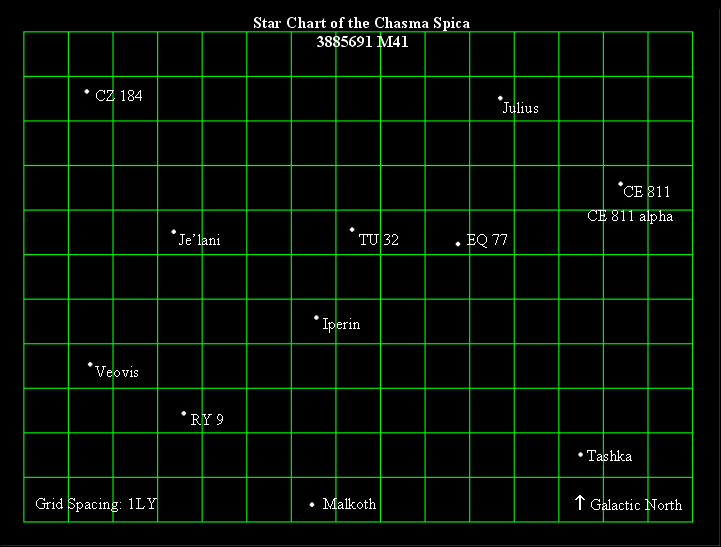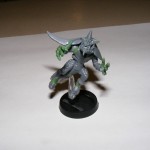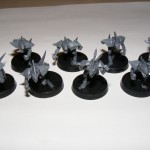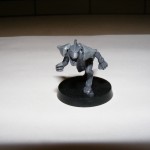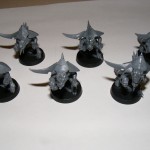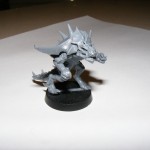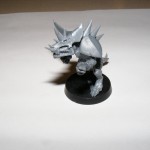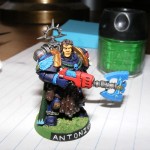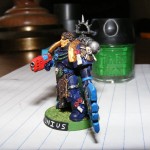The Star Systems of the Chasma Spica
The Star Systems of the Chasma Spica
An Astronomical and Geological Report by the Emperor’s Humble Servant: Magos Tukmehn Kelhar
Abstract
The Chasma Spica has long been closed to Imperial surveyors due to an ever-present Warp Storm. I had the fortune of being a guest aboard the Adeptus Mechanicus Explorator ship Menelaus during its discovery that the Warp Storm had dissipated. The Chasma Spica consists of a relatively dense region of space approximately 15 LY by 10 LY in the Segmentum Tempestus to the Galactic Southwest of Pavonis. It contains eleven previously recorded but unexplored Star systems. Surveys discovered that six of these systems have valuable planets. These six systems were renamed, to better identify them. Due to enemy presence, a full Geologic survey of each planet was impossible. However, with the assistance of the Azure Flames Adeptus Astartes chapter, data about each planet was gathered to the maximum degree possible.
Methods
Due to such a large number of star systems being explored in such a short period of time, the Azure Flames Adeptus Astartes Chapter assisted me by relaying their sensor data. They also launched several class theta probes to gain more information about each world. Long range sensors of the Menelaus were also used to gather information in several systems. Planetside surveys are impossible, due to unknown disposition of Chaos forces in the Chasma Spica. Several systems have very little data due to the interference of Enemy fleets.
Observations and Data
The Chasma Spica is a dense region of space. Systems are usually 2.4 to 3.8 LY from each other. The Warp storm encapsulated this entire region and an area 13 AU beyond it, denoted in previous star charts. Most of the systems are clustered around the Iperin system, with notable exceptions being the Tashka System and the CZ 184 system. Isotopic analysis of dust clouds in all eleven of these systems confirms that these nine clustered systems originated from the same parent nebula. Data collection was hampered significantly in the Je’lani and CZ 184 systems. Long range scans of these systems and brief sensor data are avaialble. Detailed observations will proceed from Galactic North to Galactic South.
CZ 184 is a Red Giant star class K. Observed surface temperature is 4,182 K. Luminosity is 2.43×10^28 Watts. No sattelites detected. Data are from long-range sensors only due to enemy interference.
Julius is a main sequence star class F. Observed surface temperature is 6,616 K. Luminosity is 4.47×10^27 Watts. Julius has three main satellites. Julius Alpha is .87 AU from Julius and has a radius of 5731 km. Due to the high temperature of Julius, and Julius Alpha’s proximity to it, and its small size, Julius Alpha has no detectable atmosphere. Tectonic forces are prevalent on Julius Alpha. Several volcanoes appear on its surface. Long-range laser seismographs aboard class theta probe indicate almost constant earthquakes. Julius Alpha is designated class delta, a dead world. Julius Beta is 1.61 AU from Julius and has a radius of 6,403 km. Julius Beta has a nitrogen-oxygen atmosphere consistent with alpha class agri-worlds. Julius Gamma is a Gas Giant 3.95 AU from Julius. Julius Gamma’s radius is 80,349 km. Julius Gamma has fourteen minor satellites. One of which, Julius Gamma Kappa, has a carbon dioxide atmosphere and frozen water. Currently classified delta tau, death world. The Julius system also has two Asteroid belts at 3.08 and 4.87 AU of light density. Most asteroids in the first belt are iron-chondrites. The second belt is composed of both iron-chondrites and ice.
CE 811 and CE 811 alpha are Binary stars orbiting each other. CE 811 is a main sequence class A with a surface temperature of 8231 K. Luminosity is 4.51×10^28 Watts. CE 811 alpha is a main sequence red dwarf class K with a surface temperature of 4090 K. Luminosity is 1.93×10^25 Watts. The CE 811 system is full of gas and dust clouds, possibly formed by extreme solar prominences during early collisions of the stars.
Je’lani is a main sequence class K with a surface temperature of 4432 K. Luminosity is 6.04×10^25 Watts. Je’lani has one satellite, Je’lani alpha, a Gas Giant at .74 AU. No further data due to destruction of probe by enemy incursion.
TU 32 is a White Dwarf class A with a surface temperature of 7743 K. Luminosity is 2.66×10^22 Watts. Large amounts of gas and dust clouds and asteroid fields indicate that TU 32 was much larger and went nova as it accreted a hypothetical gas satellite.
EQ 77 is a Red Dwarf main sequence class M with a surface temperature of 2973 K. Luminosity is 1.362×10^23 Watts. Asteroids and gas and dust clouds present in great amounts. EQ 77 was most likely a larger Red Giant that ran out of Helium and collapsed. It is currently fusing larger elements to stay lit. It does not have the mass required to collapse into a singularity. EQ 77 has one minor satellite, EQ 77 alpha, at 4.2 AU. It has an average radius of 1973 km. EQ 77 alpha is extremely irregular and completely uninhabitable.
Iperin is a main sequence star with a surface temperature of 5814 K. Luminosity is 1.034×10^26 Watts. The Iperin system has several satellites. Iperin Alpha is .709 AU out, and has a radius of 3107 km. Iperin Alpha has a thin CO2 atmosphere, similar to the proto-atmosphere of Mars. Infared readings and tectonic scans indicate no internal planetary energy; hence Iperin Alpha is classified as a class delta, dead world. Iperin Prime is 1.13 AU out and has a radius of 5,982 km. Despite the smaller radius, gravitometric scans indicate that surface G is approximately 1, which leads me to believe that the core of this world is slightly more enriched in Iron than Holy Terra. Magnetic readings unavailable. Atmosphere is a 65% N2, 18% O2, and 12% Argon, with variable other gases such as CO2 and water vapor. High-orbital photography indicates complex weather systems, two main continental masses, and a large planet-spanning ocean. Ice caps exist on both poles. The southern continent is also partially covered by ice. Tectonic scans indicate that this is a geologically active world. Iperin prime also has two moons, Iperin Prime Alpha and Beta, which orbit at distances of 10,342 km and 14,376 km respectively. Both moons are delta class dead worlds and have no atmospheres. Iperin Prime is designated alpha class. Iperin Gamma is 1.9 AU out and has a radius of 1,903 km. It has a thin atmosphere composed of CO2 and other trace gases, and is designated a class delta dead world. Iperin Delta is a gas giant 4.38 AU out, and has a radius of 80,311 km. Iperin Delta has an extensive system of rings, numbering approximately 483. Iperin Delta has several hundred moons, all of which are asteroids or delta class dead worlds with a radius of less than 1,500 km, except for one moon designated Iperin Delta Upsilon. This moon has a radius of 3142 km and has an atmosphere compsed of 32% water vapor, 54% CO2 and 10% O2 with other trace gases. Iperin Delta Upsilon has liquid oceans that undergo huge tidal action because of the moon’s proximity to Iperin Delta. This tidal action causes friction, which keeps the oceans liquid despite Iperin Delta Upsilon’s distance from its star. According to spectrographic scans, these oceans are rich with chloroplast bearing lifeforms which provide the oxygen component of the atmosphere. The carbon dioxide rich atmosphere means that human beings should wear CO2-scrubbing respirators while on Iperin Delta Upsilon. Several volcanic islands dot the moon’s surface, and tectonic sensors show incredible stress on the moon’s plates, probably due to the same gravitational shearing that cause it’s tidal action. Iperin Delta Upsilon is designated delta tau, death world, due to its treacherous shifting oceans, tectonic and volcanic action, and extreme temperatures. Iperin Epsilon is a gas giant 7.12 AU out, and has a radius of 58,984 km. It has a minor ring system numbering 13 rings, and has several moons, none of which are significant.
Veovis is a main sequence star with a surface temperature of 5,002 K. Luminosity is 7.9×10^25 Watts. The Veovis system has one primary satellite and several gas and dust clouds, and asteroid belts. Asteroid belts are located at 3.8, 4.7 and 8.2 AU out from Veovis. Veovis Alpha is a gas giant 1.83 AU out and has a radius of 97,313 km. Veovis Alpha has several moons, but only two moons of significance; Veovis Alpha Gamma and Veovis Alpha Zeta. Veovis Alpha Gamma is an iron-chondrite concretion approximately 847km in diameter. It has no atmosphere and is designated delta class, death world. Veovis Alpha Zeta is 1,382 km in diameter and has an atmosphere composed of 63% CO2, 23% water vapor, 12% H2SO4, and 8% complex hyrdocarbons. Seismic readings indicate minor tectonic activity. Long-range spectrographic scans identified several large bodies of liquid on the surface of Veovis Alpha Zeta consisting of various complex hydrocarbons. Veovis Alpha Zeta is classified delta tau, death world.
RY 9 is a white dwarf with a surface temperature of 9,382 K. Luminosity is 2.38×10^23 Watts. RY 9 has several gas and dust clouds, and scattered irregular asteroid fields.
Tashka is a giant with a surface temperature of 4,587 K. Luminosity is 1.87×10^28 Watts. The Tashka system has one major asteroid belt at 3.63 AU from the primary. Tashka has two primary satellites. Tashka Alpha is 2.65 AU out and has a radius of 2,982 km. Tashka Alpha has no atmosphere and is designated delta class, dead world. Tashka Beta is a gas giant 4.74 AU out and has a radius of 91,283 km. Tashka Beta has a ring system numbering 37 rings. Tashka Beta has five moons, the only significant moon of which is Tashka Prime. Tashka Prime has a radius of 4,782 km and has an atmosphere composed of 63% N2, 21% Argon, 12% O2, and other trace gases. The moon has several liquid oceans and consists of mostly volcanic archipelagoes with one major continent straddling the moon’s equator. Tashka Prime is classified lambda class, livable world.
Malkoth is a main sequence star with a surface temperature of 6,359 K. Luminosity is 1.6×10^26 Watts. Malkoth has asteroid belts at 4.3 and 11.6 AU. Malkoth also has extreme gas cloud distribution and random asteroid fields ranging from 6.9 to 7.3 AU out. Possibly remnants of two or more gas giants that collided or were torn apart somehow. Malkoth Alpha is 1.3 AU out and has a radius of 5,612 km. It has an atmosphere composed of 68% N2, 28% CO2, and other trace gases. Tectonic activity is minimal. Extensive life signs detected from orbit, type unknown.
Conclusions
The Chasma Spica has an incredible wealth of unexplored livable or exploitable worlds. Several of the dead worlds in a variety of systems would be perfect for class rho research stations. Julius Beta, Iperin Prime, Iperin Delta Upsilon, and Tashka Beta Delta are currently habitable by human beings. Julius Beta is the ideal candidate for an agri-world, but is too valuable for its cropland than for any other purpose. Iperin Delta Upsilon would be suitable as an agri-world if the local life proves nutritious, or if a suitable replacement can be introduced. Iperin Prime and Tashka Prime are the finds of a lifetime. Both are extremely earthlike and could be put to any number of purposes including Hive worlds. Malkoth Alpha could also become usable after terraforming processes alter the atmosphere. Veovis Alpha Zeta is a hazardous world, but the natural complex hydrocarbons in its atmosphere and oceans are ideal for refinement into promethium and other fuels. I recommend that Imperial forces seize control of the Chasma Spica at all costs.
Magos Tukmehn Kelhar
Magos Supremis Geologis
Getting the Band Back Together
So one day my friend Scott came up to me and said “We’re doing another Big Game a year from now.”
I don’t know how to describe what I felt next because it was a new feeling. But it was awesome.
Here’s some history. Our old gaming group, Studio 40K, used to play in Mary Mayo hall. Every once in a while, we’d put on Big Games. The first and second Big Games took place on the floor of a pole barn on my friend Jake’s parent’s christmas tree farm. It was huge, but painful as we knelt on concrete for twelve hours. The third was on the 4th floor of the MSU Union, and then the fourth was back in the pole barn (because it was free). Players were divided onto the “good” and “evil” sides.
I had mixed feelings about the earlier games. In the first I wasn’t able to do much besides make Andy’s Necrons phase out, and one of our players was kind of screwed over. His name was also Andy and he played Dark Angels. He was told to take a 100% deep striking force, but was forced to deep strike within 24″ of an objective, so his army was essentially deployed randomly, piecemeal, in a useless place. He lost two units to the Perils of the Warp. We never saw him again. There was no fluff for this game, people just played.
In the Second big game, I was face-to-face with an outnumbering force of Eldar, and I had a mounted force ready to assault. Sadly, I was not allowed to move on turn 1, essentially turning my vehicles to tombs. The scenario also favored the “evil” side, as we had a Titan that was supposed to “march” to a city to liberate it. Unfortunately you can’t march if there’s an enemy within 48″ and the Evil side had John, a Tyranid player. His Lictors kept the titan from marching. This game had a backstory by Joe, that an evil artifact allowed Chaos to control other evil armies.
The third was essentially twelve small games going on at once. I faced John’s Tyranids across a “cornfield.” These were essentially forests that you could see 12″ into instead of 6″ like normal. However, John’s Tyranids could assault MORE than 12″. Half of my force retreated to help another board, but we had a lot of bad matchups. Guard vs. Necrons in the city could not pop Monoliths because they were hull down, and the Monolith blasted everything. Dan’s Tau marched (stupidly) right up Andy’s Necrons’ throat. Dave (former 21C manager) ran across a death field at an artillery heavy Iron Warriors army. Comedically there was ONE mismatch the other way. Brian’s Orks were trapped on the other side of a huge trench and were pounded by Damon’s Guard. Sadly the good guys had one guard plauyer whose name escapes me, and he was a huge cock the whole time. In this story, the evil sword from the first story continued to control the bad guys. It was now wielded by an Ork Warboss!
In the fourth, the game was much more balanced. In the end, Brian’s Ork bikers turned a Good Victory into a tie. I remember my knees being sore, and Scott almost died. The good guys really did not deserve to win, as we made several mistakes like deploying our Thunderhawk in the middle of the goddamn board. The evil sword was now in the hands of the nefarious Victor Kalan. His brother, Inquisitor Angmar Kalan, led the forces against him. To break the tie, Victor and Angmar fought close combat. They killed each other! A true tie!
So that’s where I thought it would have ended. Then Scott said that wonderful sentence. It led me to a year of some of the most intense creativity I have ever experienced. It also encouraged me to finish every little thing for the Azure Flames, including a bevy of named Captains.
Details on Big Game 5 to follow in a later post.
Blood Bowl: The Konquata Monitors
Recently I got into Blood Bowl. I haven’t played a game (due to a traffic jam DAMMIT) but I have a serviceable team raring to go. We are the Konquata Monitors, a Lizardmen team. Here is an image dump:
As you can see, I have six Saurus Warriors, eight Skinks, and two Saurus Star players. The Saurus were made from Temple Guard with Saurus Warrior left arms and Tyranid Carnifex armor plates. The Skinks have Genestealer armor plates cut in half. Each half makes one shoulder pad.
For the star players, there were no open hands available in the Lizardmen line. So, I used a piece of putty, coated it with oil, and wrapped it around the fist. Then, I CAREFLLY removed the mould and flattened it out. This gave me straight fingers. I then moulded the fingers over and over until I got enough to do each hand. Each finger was cut out, trimmed, and putty was added to fill out the finger. Putty was also added to make new nails. The one on the flying base represents the Star Player Lottabottol, who has diving catch. The other is Sillibilli who has block.
In the Warhammer Fantasy world, the Lizardmen have recently conquered the island of Albion, which they call Konquata. Lord Kroak personally formed the Konquata Monitors out of Saurus and Skinks from the First Spawning from the newly made spawning pools on Albion. Their mandate is to dominate the sport of Blood Bowl to advertise that Albion will belong to the Lizardmen for all time.
Next up: more Skinks including Star Player Hemlock, and a Kroxigor modded with Trygon bits!
Memorable Games – The Fall of the Myridian Suns
Everyone has games that were so awesome, they’ll never forget them. This could be because of a victory that makes a story worth telling, or a loss that is so hilarious you can’t help but smile. I’ll be posting reports of games I’ve had that went down in the history books.
Back in the old days of Studio 40K in Mary Mayo hall, one of my fellow players was Dan. He answered as easily to his own name as he did to “Rock Star.” He was sort of a hipster. He played mostly Tau, but also had a Space Marines chapter of his own making, called the Myridian Suns. They were Sunburst Yellow with black rims and a black sun with eight rays coming out of it. I was playing against his Myridian Suns with my Azure Flames Space Marines.
Most of the details of the battle are lost. However one important fact was that I took a 5 man Devastator squad with 4 Lascannons, and they deployed in a central ruined building with lines of fire to many different parts of the board. Dan got the first turn and made these Devastators a priority. His entire army unloaded, and killed all but one Lascannon.
Undeterred, the Lascannon made his morale check and proceeded to blow up a Land Raider.
The rest of Dan’s army advanced, and my army and his slugged it out. However, he took the loss of the Land Raider personally and chose to fire a large amount of his army at this lone Lascannon Devastator. He amazingly survived, accounting for (by the end of the game) The Land Raider, a Dreadnought, and some Terminators. This annoyance distracted Dan, and let me outflank him. I named the Lascannon marine Brother Stephen and painted his shoulder rims gold and promoted him to the 1st company. Here is a story I wrote a while ago. After this game, Dan sold off his Myridian Suns piecemeal, and so I thought that they had turned to Chaos and been exterminated.
Brother Stephen’s service during the fall of Myridia.
The Land Raider exploded, spraying shrapnel. Stephen smiled. A bolt round ricocheted off of Stephen’s helmet. The window he was firing from partially disintegrated under the hail of fire from the traitors. Stephen calmly knelt and replaced the battery pack in his Lascannon. A groan from the corner signified that Sergeant Xin’s wound was serious but not fatal. Stephen stood and sighted for another target. He dodged to the right quickly as a Krak missile flew through the space where his head was, and blew out the ceiling three meters behind him. He sighted a Dreadnought and fired. Fire ripped through its Sarcophagus, and it collapsed in a pile of slag. He once again took cover as more of the wall disintegrated around him. The traitor chapter was throwing all their firepower at him. Stephen put that thought out of his mind, stood, and sighted once again. Five Terminators advanced on the building Stephen occupied, their garish yellow livery now decorated with signs of the ruinous powers. Stephen cursed them as he fired, and one fell. They would reach him, but he would take as many of the Myridian Suns with him as he could. The Terminator’s Storm Bolters barked fire, and Stephen had to move to the next window. Shots rang off of his greaves. Stephen uttered a prayer of thanks and fired again, felling another Terminator.
“For Atrus’ sake, get down Stephen!” Xin coughed. He seemed to be staring off into the distance. Another Krak missile blew out the wall, and Stephen had to heave a large piece of rubble off of himself.
“You should not be moving about sir. Let me take care of the traitors.” He replied.
“No, you don’t under…” he cut off, hacking blood. “…Vindicators!”
Stephen’s eyes went wide, and he gently set his Lascannon down, walked to Sergeant Xin, lifted him, and moved him to the center of the building as thunderous booms seemed to tear the world apart. Minutes later his vox link came to life.
“Surviving Azure Flames, this is Captain Valerien. Report.” Several other squads reported in. The traitors were in retreat and their lines had been shattered.
“10th squad 5th Company reporting. This is Brother Stephen. Sergeant Xin is injured and the rest of the squad is dead. We are in hab complex J on the west side of the encampment.”
“Stephen, Valerien. Confirm hab complex J?”
“Valerien, Stephen. Confirmed.”
“Excellent work, Brother. Your squad seemed to draw the fire of all the traitors at once. Your distraction allowed our Vindicators to get into position, and your fire suppressed the traitor’s advance. What was your squad’s kill count?”
“The squad took fire before we got into position. I was the only man left standing. I accounted for a Land Raider, a Dreadnought, and two Terminators.”
Silence answered.
Stephen’s vox burst with wild cheers. Stephen sat and lowered the volume on the vox. As the medivac arrived, reports had come in that the Myridian Suns’ fleet had been utterly annihilated. Stephen hefted the stretcher with Xin, and estimated that the Myridian Suns would be erased from the galaxy in two days, at most.
Zeraf Antonius, Captain of the 4th Company
Aesthetically based on my cousin Anthony, Zeraf Antonius is currently the Captain of the 4th Company of the Azure Flames, Master of the Marches. Antonius is the youngest Marine promoted to captain, at a mere 23 years old since his actual birth, and 6 years since the implantation of the Black Carapace.
Antonius grew up on an agri-world. It was invaded by Orks, and rescued by the Azure Flames. Antonius was one of several youths to volunteer for service with the Chapter. He underwent the various implantation procedures to become a Scout. Unbeknownst to him, the gene-seed of the Chapter Master, Atrus, was extracted when he was interred in the sarcophagus of a Dreadnought. Only one of his two gene-seeds survived. Atrus instructed that his gene-seed be used to make Antonius a Space Marine.
Antonius’ career as a scout was full of valorous deeds. He was one of two survivors of his Scout squad against an attack by Eldar. He led a scout squad to victory on Morvan Prime, and discovered documents that prevented Tenkath Hive from being infiltrated by Chaos agents. The people of Tenkath dubbed him “The Hero of Tenkath Hive.”
Antonius participated in the rite of Ascension at age 17 and was implanted with the Black Carapace. He served in the 9th and 8th reserves, before being transferred to the 6th Tactical reserves. He participated in the planetary assault on Arkh, and several other major battles.
Antonius was transferred into the 4th company by the direct order of Atrus during the Chasma Spica conflict. He was part of the tactical squad that infiltrated Iperin, and took over as their sergeant when Sergeant Joseph was killed in action. He led the 5th squad and enraged the jealousy of the Traitor Gehn, then sergeant of the 6th squad.
Antonius was part of the interdiction force on Julius when Gehn was captured and turned to the service of the dark gods. When Captain Ganendra was killed during a bombing run in the final battle for Julius, Antonius took command of the Flames’ detachment and led them during the final victory that drove both greenskin and Chaos forces from the planet. Though reluctant to take up the axe of his former commander, Antonius was unanimously awarded command of the Fourth Company by those who remained after the war. With Atrus having met his end during the terrible battle over the city of Daskros, Antonius’ genetic heritage was finally revealed to him.
Antonius continues to lead the 4th company to victory, either from the bridge of the Strike Cruiser Honor, or on the battlefield. He struggles with the knowledge of his origin, and the destiny that the apothecaries speak of. They say that one day he will lead the Azure Flames, but until the “Old Man” Chapter Master Perseus dies, Antonius will remain in the office, and will continue to faithfully serve.
Antonius is a stand-in for Cato Sicarius in 40K, and commands the Strike Cruiser Honor in Battlefleet Gothic.
Index Astartes
I added a new page: the Index Astartes article for the Azure Flames.
http://fourstrandshobby.com/index-astartes-the-azure-flames/
How I got into gaming: The Azure Flames
Everyone who is a gamer gets into it somehow. I got into it when my friend Joe invited me to a meeting of Studio 40K, the wargaming club of MSU (now defunct, different rant later). This was in the winter of 2000/2001, early in the 3rd edition of 40K. I picked Space Marines, specifically the Salamanders. They had cheap Terminators and never gave up. However, I didn’t like green marines, so I made my own successor chapter: the Azure Flames.
My first purchase was a Devastator squad. The old pewter devastator box which had all the heavy weapons except the Multi Melta. Actually a really bad box set, as a dev squad with those weapons was expensive and almost useless. I learned and collected quickly though. That following summer I followed this pattern: buy unit, paint unit, buy another unit. I eventually had one of everything the Space Marines could take. And I kept going.
Then, during the very last auction that Games Workshop held in its stores, I won a Blood Angels combination, consisting of Dante and some honor guard, some Death Company, and a few other things including a Baal Pred. I made them into a Flesh Tearers army that was actually pretty impressive. Sadly, after the advent of 4th ed, Blood Angels were vastly underpowered and I never played them. I sold the lot bit by bit at a con. People went nuts for the paint jobs and the custom vehicles. My greatest pleasure was selling the remainder and the custom case to a kid who never had an army. Made me feel good.
At this time, 4th edition was in it’s crappy heyday. Vehicles were rolling tombs and gunline tactics were boring as hell. That’s when my good friend Lexington got me into Warmachine. I chose to play Cygnar, the jewel of the Iron Kingdoms. I expanded into mercenaries, as long as they worked with Cygnar. Warmachine and I have had an on-again off-again relationship, as Privateer Press tends to make wonderful systems and then break them with ridiculous new combos. 2nd ed is a million times better than 1st though.
Then, the newest Ork codex came out. Orks were fun. I toyed around with ideas and made my own “counts as” characters corresponding to all the characters in the new Codex. I knew I had to play. So I bought a huge amount of Orks, and made the warband of Poindexta Smartyskull, the Ork with two brains! I did weird and ridiculous conversions and tried a new painting method: dipping. It worked great.
Then (once again thanks to Lexington) I found the sweet, sweet crack rock of Specialist Games. This was back in 2007, when ChaosOrc had stock. I actually purchased enough Epic scale Space Marines to make an ENTIRE CHAPTER! I also camped ebay for deals on some of the newer vehicles. I played a game of Epic against Lexington’s Eldar. Then he sold them. Then I played one game against his new Chaos. Then he sold them. *sigh* He was going through rough times.
At the same time as my Epic indulgence, I found deals on Space Marine craft for Battlefleet Gothic. I became obsessed with rules, and made my own rules guides for Epic and Gothic. I took the rules and condensed them down into 10 pt single spaced outlines that essentially explain all possible things. I worked in a print shop and was able to make them into a laminated spiral bound flip chart for easy access.
Recently I’ve become a little obsessed with Specialist Games. I had a Necromunda Orlock gang I bought at a con for a campaign that never materialized, but I bought a Delaque gang, and had my friend Jen custom make me a Necromunda board that looks fantastic. I also painted my Battlefleet Gothic Space Marines, and bought and (almost completely) painted an Imperial Navy and a Chaos fleet. I also recently purchased some plastic Lizardmen and Tyranid bitz to make a Lizardmen Blood Bowl team.
As you can see, I’ve got a lot on my plate. I’ll post pictures of what I’ve done and thoughts on what I’m going to do.
…but it was A beginning.
Welcome to the Four Strands, a site dedicated to model wargaming!
What does the Four Strands mean? The hobby of model wargaming has four aspects, like four strands that make up a rope. These aspects are: Modeling, Painting, Gaming and Storytelling.
Modeling
Modeling is the first strand. Without models, you can’t really do much else! Modeling covers all aspects of collecting models and conversions. From choosing an army to customizing it the way you want to, the first strand is all about how your models look when assembled. Even those who only put together models as intended are consciously choosing to do so.
Painting
Painting is the second strand. After all, most models look OK before painting, but tend to look much better when painted well. This covers everything from proper undercoating to advanced techniques such as dynamic lighting. While some people feel that painting is optional, I find it very necessary. After all, a victory won with models that don’t look good never feels like the victory won with a fully painted and based army.
Gaming
The third strand is the goddamn point of model wargaming. While some people enjoy sculpting or painting, only model wargamers actually use those miniatures to play games. From small casual games to huge campaigns, games are for having fun! Some take this aspect very seriously, like tournament gamers. Others are content to play with their friends. Either way you go, the point is the same: to play games with other people.
Storytelling
Really? Storytelling? Am I reaching just to get a fourth strand to make this rope metaphor stick? Not at all. This is the end result of your hobby. After all, whether you won by smashing every model the opposing player owns, or lost by the narrowest margin, every model wargamer has stories to tell. This aspect covers both the stories about games you have played, and stories you write. Making up your own Space Marine Chapter, or putting on a story campaign of the war for the Thornwood makes for an immersive experience. Even if you only play the Ultramarines in tournaments, you have stories to tell. You could have won a huge victory, or lost because some jerk with hairy shoulders cheated. Stories are how the hobby perpetuates itself and how we remember our experience. Stories tie everything else together.
This blog is intended for me to explore this hobby, and chronicle my efforts. I will post things that i do including conversions, paint jobs, fluff, battle reports, and thoughts on gaming itself. I hope that you enjoy the things that I do to spend my free time!
-Bozeman
P.S. Yes I ripped off Lexington for the title of this post, but screw him. I have exactly one post on this blog and I have half as many posts as he does on his blog up for almost a year.
